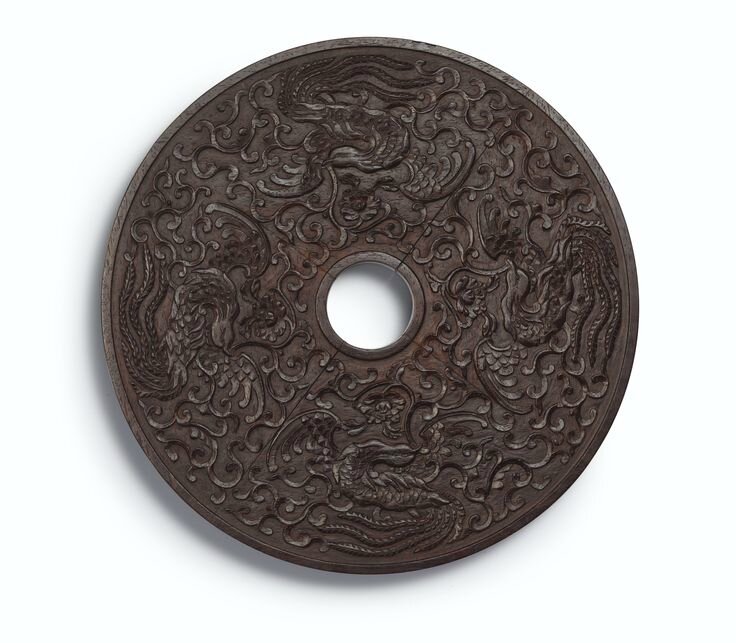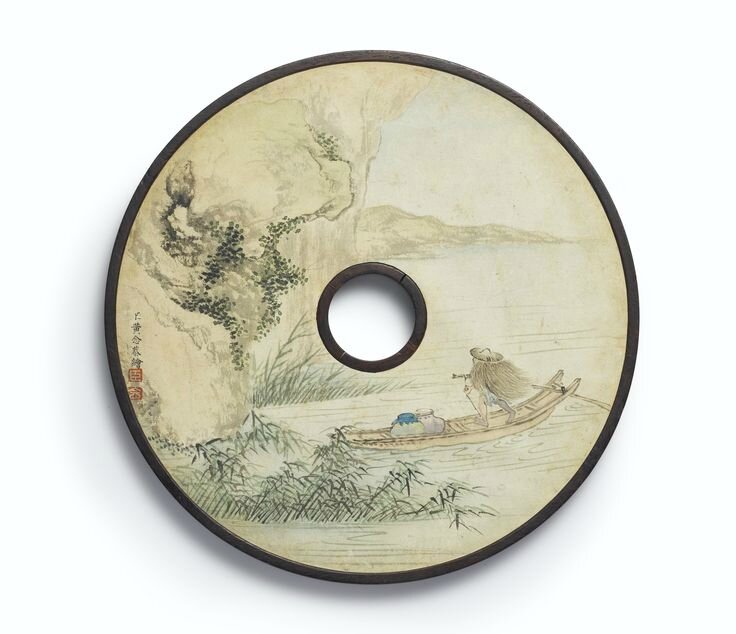A zitan box with a painting by Huang Nian, Qing dynasty, Qianlong period and a bronze 'TLV' mirror, Han Dynasty
Lot 3124. A zitan box with a painting by Huang Nian, Qing dynasty, Qianlong period and a bronze 'TLV' mirror, Han Dynasty. Estimate 2,500,000 — 3,000,000 HKD. Unsold. © Sotheby's
comprising a zitan box bordered along the edges with a key-fret band, constructed with a slidable rectangular panel forming the opening of the box; a circular zitan panel centred with a circular aperture, well carved on one side with four phoenix soaring amidst leafy floral scrolls, the other side mounted with a painting depicting a tranquil riverscape with rocky cliffs and a fisherman on a boat, inscribed with chen Huang Nian gonghui and terminating with two seal marks reading chen and nian respectively; and a bronze 'TLV' mirror with a crispy cast back centred with a knob within a square border, all surrounded by eight studs in the outerfield interspersed with the Four Spirit Animals, Daoist immortals and various animals and birds, all within a band with a faintly discernible inscription reading Shang Fang zuo jing zhen da qiao, shang you [Xian] ren bu [zhi lao], he yin ('this mirror made by the Shang Fang truly is very fine. Upon it are [immortlas] who do not [know old age] ... quench their thirst...'), delineating Han dynasty's reverence of the immortals, the circular edge bordered with three geometric bands, the bronze with a silvery-grey patina.
box 10.7 by 26.6 by 26.5 cm., 4 1/8 by 10 1/2 by 10 3/8 in. - painting 18.9 cm., 7 3/8 in. - mirror 19 cm., 7 1/2 in.
Note: Han dynasty (206 BC - AD 220) mirrors have long been treasured and have been studied by scholars as early as the Song dynasty (960-1279). Densely decorated with ‘TLV’ motifs interspersed with mythical animals, the current piece represents a fine example in spite of its barely legible inscription. Similar pieces with comparable inscriptions in the Qing court collection can perhaps shed some light on the present incomplete inscription; see for instance a Shang Fang mirror adorned with similar motifs, encircled by a long inscription which can be translated as “The mirror made by the Shang Fang truly is very fine. Upon it are immortals who do not know old age. They quench their thirst with the springs of jade, satisfy their hunger with jujubes, drifting in the world and travelling to the four seas. [May you have] long life like [that of] metal and stone, and [may you have] Heaven’s protection,” 1 included in Xiqing gujian [Catalogue of Xiqing antiquities], no. 39, pp. 3-4.
Shang Fang, recorded in Han shu [The book of Han] to be an imperial workshop, is believed to be responsible for the official production of bronze mirrors. The name of the imperial department, however, was very soon adopted by common workshops which manufactured mirrors with apocryphal Shang Fang marks. The ‘TLV’ motif seen on the present piece is closely related to the liubo game board popular during the Han dynasty. This connection is evidenced by the inscription “Engrave the boboard so as to expel the inauspicious,”2 found on a bronze mirror in the collection of the Tokyo National Museum, first published in Nishida Morio, ‘Hōkaku kiku kyō no zumon no keifu: kokurō hakugyoku kyo fuyō no meibun motsu kyō ni tsuite’, MUSEUM, no. 427, Tokyo National Museum, Tokyo, 1986, p. 31. The ‘TLV’ motif, together with mythical animals, echoes the widespread Han dynasty belief in immortality, when tales and pictures of immortals were not uncommon. For a detailed discussion of the relationship between the liubo game and immortality, see Lillian Lan-ying Tseng, ‘Representation and Appropriation: Rethinking the TLV Mirror in Han China’, Early China, no. 29, Berkley, 2004, pp. 163-215.
Mirrors from the Han dynasty have been the subject of scholarly research and collectors’ desire for centuries. As early as the Song dynasty, literati compiled catalogues recording in great detail the decorations and inscriptions found on these ancient mirrors, in the hope of learning the past through these ancient objects. One of the earliest catalogues was the Xuanhe bogutu[Illustrated record of ancient objects in the Xuanhe palace] which was published during the reign of Huizong (r. 1100-1126). During the Qing dynasty (1644-1911), continuing the spirit of the Xuanhe compilation and displaying his reverence for the past, the Qianlong Emperor commanded that four comprehensive multi-volume catalogues be made of ancient bronzes in the court collection, documenting – with illustrations – the size and decoration of each antique and the inscriptions found thereon.
Included in the catalogues were sizable imperial collections of mirrors. The antique mirrors were then carefully preserved in tailor-made wooden boxes or cases in the form of an album, accompanied by delicately carved wooden covers decorated with colour paintings by court painters. These collections constituted a significant part of the Emperor’s private museum.
The cover of the present lot is carved from the finest zitan wood, decorated in low relief with phoenix amongst peony scrolls and backed with a painting of a returning fisherman by Huang Nian, who started serving in the court in the capacity of enamel craftsman in the 37th year of the reign (1772); see First Historical Archives of China, and Art Museum, the Chinese University of Hong Kong, eds., Qinggong neiwufu zaobanchu dang’an zonghui [General archive collection of the office of manufacture of the Qing Palace imperial household department], vol. 35, Beijing, 2005, pp. 559-560. Various paintings were painted by Huang during his service at the court, including the scroll Along the River during the Qingming Festival, completed in the 39th year (1774), after a Ming dynasty version, now in the collection of Liaoning Provincial Museum, exhibited in The Prosperous Cities: A Selection of Paintings from the Liaoning Provincial Museum, Hong Kong Museum of Art, Hong Kong, 2009, pl. 12.
Mirrors included in the four catalogues were originally preserved within album-like cases with fitting recesses, some of which were paired with brocade cushions and a disc-shape wood top. Comparable cases and accessories can be found in the National Palace Museum, Taipei; see Mirror Case of volume 11 of Ningshou xu jian [Sequel of the catalogue of antiquity at the Palace of Peaceful Longevity], accession number gu tong 000497; and a mirror of the five types of auspiciousness, modelled after the Han dynasty prototypes with mythical animals, with a yellow brocade cushion as well as a wood cover decorated with swastika and floral scrolls and mounted with a landscape painting by Qiang Mao, accession number gu tong 000513.
Given that very few of these mirrors now exist outside of museum collections, it is extremely rare to find an example which is not only intact but which has its Qing imperial packaging fully preserved.
Sotheby's. Imperial Porcelain and Works of Art from a Hong Kong Private Collection, Hong Kong, 07 april 2015, 10:15 AM

/https%3A%2F%2Fprofilepics.canalblog.com%2Fprofilepics%2F1%2F0%2F100183.jpg)
/https%3A%2F%2Fstorage.canalblog.com%2F03%2F02%2F119589%2F96711876_o.jpg)
/https%3A%2F%2Fstorage.canalblog.com%2F11%2F31%2F119589%2F94773502_o.jpg)
/https%3A%2F%2Fstorage.canalblog.com%2F20%2F83%2F119589%2F94772815_o.jpg)
/https%3A%2F%2Fstorage.canalblog.com%2F26%2F72%2F119589%2F75604929_o.jpg)
/https%3A%2F%2Fstorage.canalblog.com%2F59%2F60%2F119589%2F26458628_o.jpg)






/http%3A%2F%2Fstorage.canalblog.com%2F98%2F98%2F119589%2F129097971_o.jpg)
/http%3A%2F%2Fstorage.canalblog.com%2F93%2F75%2F119589%2F128489120_o.jpg)
/http%3A%2F%2Fstorage.canalblog.com%2F09%2F29%2F119589%2F128488304_o.jpg)
/http%3A%2F%2Fstorage.canalblog.com%2F62%2F18%2F119589%2F128488091_o.jpg)